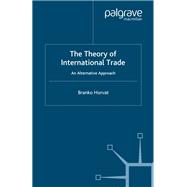
What is included with this book?
| List of Figures | p. viii |
| Preface | p. ix |
| List of Symbols | p. xiv |
| List of Abbreviations | p. xvi |
| Introduction | p. 1 |
| The Mainstream International Trade Theory | |
| The Evolution of International Trade Theory | p. 7 |
| The Heckscher-Ohlin Theory | p. 10 |
| Preliminaries | p. 10 |
| The Heckscher-Ohlin Theorem | p. 12 |
| The Factor-Price Equalization Theorem | p. 15 |
| The Stolper-Samuelson Theorem | p. 21 |
| The Rybczynski Theorem | p. 22 |
| Critique | p. 24 |
| The validity of underlying assumptions | p. 24 |
| The validity of neoclassical economic theory | p. 27 |
| Empirical evidence | p. 28 |
| The Evaluation of the Heckscher-Ohlin theory | p. 29 |
| Appendices to Part I | p. 32 |
| Empirical evidence | p. 32 |
| Leamer's attempt at reconciliation of the theory with facts | p. 33 |
| The Systemic Theory of Value | |
| Diachronic vs Synchronic Labour Input: The Two-Century Old Misunderstanding | p. 39 |
| The Employment Effect | p. 42 |
| The Replacement Effect | p. 45 |
| The Interplay of Employment and Replacement Effects | p. 50 |
| The Traverse | p. 54 |
| The Basic Three-Industry Model | |
| Steady State | p. 59 |
| Integrated world economy | p. 59 |
| Open economy | p. 62 |
| Growing economy | p. 63 |
| The Wage-Rental Curve | p. 67 |
| Appendix to the Part III | p. 70 |
| A note on price movements | p. 70 |
| An Alternative Theory | |
| Three Models | p. 75 |
| The two received models | p. 75 |
| An alternative model of international trade | p. 77 |
| Comparative advantage | p. 79 |
| Intra-Industry Trade | p. 82 |
| Four Hypotheses | p. 85 |
| Comparative advantage hypothesis | p. 85 |
| Two commodities | p. 85 |
| Many commodities | p. 88 |
| Equalization of factor prices hypothesis | p. 89 |
| Hypothesis about the changes due to the opening of trade | p. 90 |
| Increased factor supply specific effect | p. 92 |
| The Gains from Trade | |
| The Pattern of Specialization | p. 95 |
| Given autarkic prices | p. 95 |
| Primary and secondary specializations | p. 99 |
| The Gains from Trade | p. 104 |
| Autarky vs. trade | p. 104 |
| Domestic and international prices | p. 106 |
| Import and export gains | p. 108 |
| Wage-rental curve again | p. 111 |
| Unequal Exchange | p. 116 |
| Marxian values | p. 116 |
| Unequal exchange I | p. 118 |
| Unequal exchange II | p. 120 |
| Tariffs | |
| Tariffs and Subsidies | p. 125 |
| Effects of a tariff in a single market | p. 125 |
| Prohibitive tariff and subsidy | p. 127 |
| The pattern of specialization with tariff | p. 127 |
| Nominal and effective tariffs | p. 129 |
| Subsidies | p. 132 |
| Infant industry support | p. 133 |
| Customs Union | p. 136 |
| Degrees of economic integration | p. 136 |
| Trade creation and trade diversion | p. 137 |
| Customs unions in a more realistic setting | p. 140 |
| Dynamic effects | p. 144 |
| Appendices to Part VI | p. 150 |
| Empirical evidence | p. 150 |
| Economic integration of Eastern Europe: The Project Bridge | p. 155 |
| Introduction | p. 155 |
| The Organization | p. 160 |
| The Customs Union | p. 162 |
| The Monetary Union | p. 172 |
| Notes | p. 190 |
| References | p. 192 |
| Name Index | p. 197 |
| Subject Index | p. 199 |
| Table of Contents provided by Syndetics. All Rights Reserved. |
The New copy of this book will include any supplemental materials advertised. Please check the title of the book to determine if it should include any access cards, study guides, lab manuals, CDs, etc.
The Used, Rental and eBook copies of this book are not guaranteed to include any supplemental materials. Typically, only the book itself is included. This is true even if the title states it includes any access cards, study guides, lab manuals, CDs, etc.